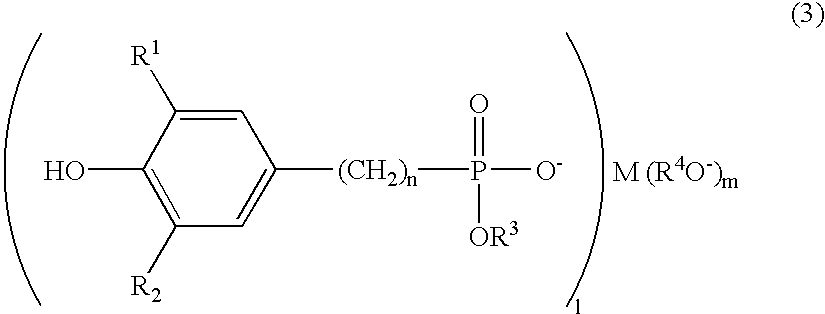Polyester polymerization catalyst, polyester produced by using the same, and process for producing polyester
a polymerization catalyst and polyester technology, applied in catalyst activation/preparation, metal/metal-oxide/metal-hydroxide catalysts, synthetic resin layered products, etc., can solve the problems of deficiency in the surface of film, deterioration of polyester, and deterioration of polyester color
- Summary
- Abstract
- Description
- Claims
- Application Information
AI Technical Summary
Benefits of technology
Problems solved by technology
Method used
Image
Examples
example 1
[0365](Synthesis of the phosphorus compound)
[0366]Synthesis of the phosphorus compound (NMPA) represented by formula (25) above
[0367]Synthesis of O-Ethyl (1-naphthyl) methylphosphonate (NMPA)
[0368]A mixture of 8.31 g (50 mmol) triethyl phosphite and 8.83 g (50 mmol) 1-chloromethyl naphthalene was heated for about 30 minutes until the evolution of gas (C2H5Cl) at 200° C. (external temperature) was finished. The reaction mixture was cooled to room temperature, to give 10.38 g NMPA (crude yield, 75%) as colorless oily liquid.
[0369]1H-NMR(CDCl3δ):
[0370]1.151 (6H, t), 3.641 (2H, d), 3.948(4H, m), 7.381–7.579 (4H, m), 7.749–7.867 (2H, m), 8.088–8.133 (1H, m)
[0371](Polymerization of polyester)
[0372]A heat transfer medium-circulating 2-L stainless steel autoclave equipped with a stirrer was charged with high-purity terephthalic acid and ethylene glycol in the molar ratio of 1:2, then triethylamine was added in an amount of 0.3 mol-% relative to the acid component, 50 g / l of the above-descri...
example 2
[0376]A BHET mixture was obtained in the same manner as in Example 1. To this BHET mixture were added 2.5 g / l aluminum acetyl acetonate in ethylene glycol in an amount of 0.015 mol-% in terms of aluminum atom relative to the acid component in the polyester and 50 g / l magnesium acetate.4H2O in ethylene glycol in an amount of 0.01 mol-% in terms of magnesium ion relative to the acid component, and the mixture was stirred at 245° C. for 10 minutes in a nitrogen atmosphere at normal pressure. Then, the temperature was increased to 275° C. over 50 minutes while the pressure in the reaction system was gradually reduced to 0.1 Torr, and the polymerization reaction was further conducted at 275° C. at 0.1 Torr. The polymerization time (AP) necessary for the IV of the polyethylene terephthalate to reach 0.65 dl / g is shown in Table 1.
[0377]The polyethylene terephthalate having an IV of 0.65 dl / g, obtained in the polycondensation described above, was formed in a usual manner into chips. The PET...
example 3
[0380]A BHET mixture was obtained in the same manner as in Example 1 except that the solution of NMPA in ethylene glycol was not added. To this BHET mixture were added 2.5 g / l aluminum acetyl acetonate in ethylene glycol in an amount of 0.015 mol-% in terms of aluminum atom relative to the acid component in the polyester, 50 g / l of the above-described NMPA in ethylene glycol in an amount of 0.02 mol-% in terms of NMPA relative to the acid component, and 50 g / l lithium acetate.2H2O in ethylene glycol in an amount of 0.01 mol-% in terms of lithium ion relative to the acid component, and the mixture was stirred at 245° C. for 10 minutes in a nitrogen atmosphere at normal pressure. Then, the temperature was increased to 275° C. over 50 minutes while the pressure in the reaction system was gradually reduced to 0.1 Torr, and the polymerization reaction was further conducted at 275° C. at 0.1 Torr. The polymerization time (AP) necessary for the IV of the polyethylene terephthalate to reach...
PUM
| Property | Measurement | Unit |
|---|---|---|
| pressure | aaaaa | aaaaa |
| pressure | aaaaa | aaaaa |
| temperature | aaaaa | aaaaa |
Abstract
Description
Claims
Application Information
 Login to View More
Login to View More - R&D
- Intellectual Property
- Life Sciences
- Materials
- Tech Scout
- Unparalleled Data Quality
- Higher Quality Content
- 60% Fewer Hallucinations
Browse by: Latest US Patents, China's latest patents, Technical Efficacy Thesaurus, Application Domain, Technology Topic, Popular Technical Reports.
© 2025 PatSnap. All rights reserved.Legal|Privacy policy|Modern Slavery Act Transparency Statement|Sitemap|About US| Contact US: help@patsnap.com



